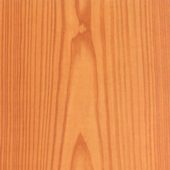Larch (Larix decidua)
The European Larch: (Larix decidua), pine/softwood from the Conifer family (Pinaceae).
Natural range
The Larch is commonly found in northern and mountainous regions of Europe, Asia and North America – even on dry ground that is low in nutrients, though not on distinctly sandy ground.
Description of the wood
Larches are heartwood trees. The initially cream-coloured to reddish-white sapwood darkens, making it easily distinguishable from the reddish-brown heartwood. Generally, Larch wood is very resinous. On the one hand, Larchwood is relatively light, on the other, however, Larches with 2 – 3 mm wide year rings are among the hardest of the coniferous timbers. Basic density is on average 0.60 g/cm³, may be up to 10% lower, depending on origin, but can be well above this in timbers from higher altitudes.
Workability
Larch wood is mainly sawn or sometimes barked, though all forms of working can be carried out quite easily. Spiral growth, however, can pose problems occasionally, and the high resin content can smear up the tools.
Durability
In contrast to accepted opinion, the heartwood of the Larch is only of moderate to low durability (durability class 3 - 4 acc. to DIN EN 350-2). It is not resistant to wood-destroying insects (house long-horn beetle, common furniture beetle). You can find an overview of durability levels of the various wood species here.
Treatability
The heartwood of the Larch is practically untreatable. (treatability class 4 acc. to DIN EN 320-2), the sapwood is moderately treatable though this varies greatly. You can find an overview of treatability levels of the various wood species here.
Applications
Because of its toughness, Larch wood is used for a wide range of applications. It is used both as a constructional timber and, due to its decorative grain, as a wood for interior design. Besides its use a solid wood, Larch is also used to make sliced veneers.
